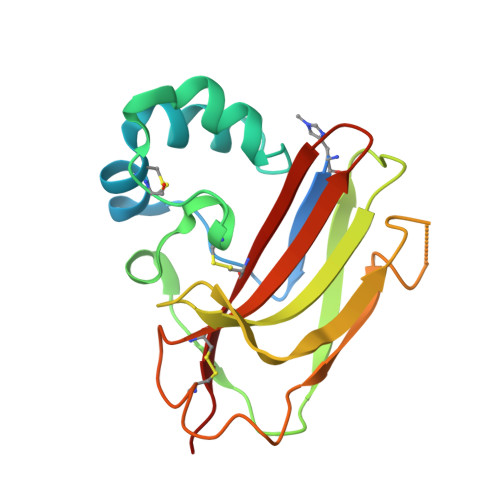AA16 Oxidoreductases Boost Cellulose-Active AA9 Lytic Polysaccharide Monooxygenases from Myceliophthora thermophila.
Sun, P., Huang, Z., Banerjee, S., Kadowaki, M.A.S., Veersma, R.J., Magri, S., Hilgers, R., Muderspach, S.J., Laurent, C.V.F.P., Ludwig, R., Cannella, D., Lo Leggio, L., van Berkel, W.J.H., Kabel, M.A.(2023) ACS Catal 13: 4454-4467
- PubMed: 37066045
- DOI: https://doi.org/10.1021/acscatal.3c00874
- Primary Citation of Related Structures:
7ZE9 - PubMed Abstract:
Copper-dependent lytic polysaccharide monooxygenases (LPMOs) classified in Auxiliary Activity (AA) families are considered indispensable as synergistic partners for cellulolytic enzymes to saccharify recalcitrant lignocellulosic plant biomass. In this study, we characterized two fungal oxidoreductases from the new AA16 family. We found that Mt AA16A from Myceliophthora thermophila and An AA16A from Aspergillus nidulans did not catalyze the oxidative cleavage of oligo- and polysaccharides. Indeed, the Mt AA16A crystal structure showed a fairly LPMO-typical histidine brace active site, but the cellulose-acting LPMO-typical flat aromatic surface parallel to the histidine brace region was lacking. Further, we showed that both AA16 proteins are able to oxidize low-molecular-weight reductants to produce H 2 O 2 . The oxidase activity of the AA16s substantially boosted cellulose degradation by four AA9 LPMOs from M. thermophila ( Mt LPMO9s) but not by three AA9 LPMOs from Neurospora crassa ( Nc LPMO9s). The interplay with Mt LPMO9s is explained by the H 2 O 2 -producing capability of the AA16s, which, in the presence of cellulose, allows the Mt LPMO9s to optimally drive their peroxygenase activity. Replacement of Mt AA16A by glucose oxidase ( An GOX) with the same H 2 O 2 -producing activity could only achieve less than 50% of the boosting effect achieved by Mt AA16A, and earlier Mt LPMO9B inactivation (6 h) was observed. To explain these results, we hypothesized that the delivery of AA16-produced H 2 O 2 to the Mt LPMO9s is facilitated by protein-protein interaction. Our findings provide new insights into the functions of copper-dependent enzymes and contribute to a further understanding of the interplay of oxidative enzymes within fungal systems to degrade lignocellulose.
Organizational Affiliation:
Laboratory of Food Chemistry, Wageningen University & Research, Bornse Weilanden 9, 6708 WG Wageningen, The Netherlands.




















